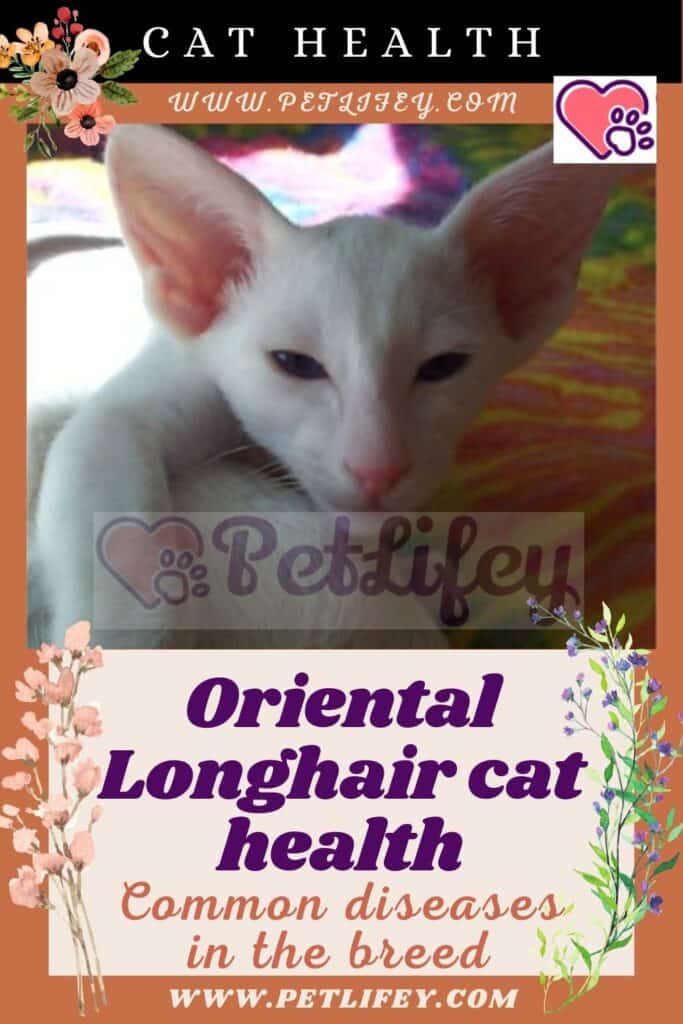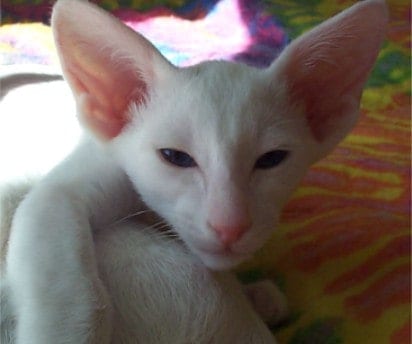Diseases of the Oriental Longhair, the most common pathologies in this exotic cat breed. Let’s find out together which ones can hit him.

Learning to recognize or prevent the diseases that can affect our pet is very important, many times thanks to an early diagnosis it is possible to save the life of our four-legged friend.
Therefore, even before it arrives in our home, let’s try to learn more about the breed that we have decided to adopt.
In the next paragraphs you will find everything you need to know about the diseases of the Oriental Longhair, the most common diseases of this cat breed.
Diseases of the Oriental Longhair

The Oriental Longhair is an extraordinarily intelligent, dynamic and lively cat. It has a life expectancy ranging from 10 to 20 years with an average of 15 years.
This cat breed suffers in particular from the cold but all in all it has a healthy and robust constitution but not immune to certain pathologies typical of the breed.
The Oriental Longhair is a medium-sized cat with a weight ranging between 3 and 6 kg. Gifted with a lean build and an elegant bearing. It has large ears, clear eyes, and a long, straight nose.
Despite this apparent muscular physicality, it is subject to some specific pathologies, namely :
- Progressive retinal atrophy: an inherited disease that leads to blindness. This disease can manifest itself in the adult age of the cat but also at a young age, with the difference that an adult and mature cat is better able to adapt to its new life as a blind person, while the kitten has little time to progressively prepare for its new life as a blind person. .
- Feline renal amyloidosis : it is a degenerative disease that is very difficult to diagnose. It usually occurs in young individuals, from the first to the fifth year of age. It is also a hereditary disease but more rare, and in any case fatal. It has symptoms very similar to kidney failure. It is the presence of an accumulation due to the deposit of amyloid substance (set of proteins) that the body is unable to expel properly. This accumulation can get to prevent the proper functioning of the affected organs and can even lead to the death of the animal.
- Gm1 gangliosidosis : an inherited enzyme deficiency that causes an accumulation of non-degraded waste within the lysosomes that alters cellular metabolism. this pathology causes neurological damage and occurs around the two years of the cat’s life, leading to total paralysis until death.
- Obesity and diabetes : despite the dry and agile body, the Oriental Longhair cat, if not carefully controlled and following a suitable diet, can find itself in a critical situation regarding obesity in cats. This breed needs daily physical exercise and it is essential to provide them with various toys that allow them to exercise (for example: scratching posts and high shelves to climb).
Some specimens of Oriental Longhair can suffer from low temperatures, so in winter it can only be let out if it is well covered. While many other subjects can suffer from oral diseases, such as:
- absorption of the enamel : the enamel tends to detach and the cat to swallow it. The teeth will look different than usual, with a tendency to have red spots on the tissues.
- carcinoma : is the tumor of the mucous membranes of the mouth. It presents with growths, ulcers and peeling of the tissues. A rather serious conduction where it is possible to try with radiotherapy;
- gingivitis in cats : an inflammation of the cat’s gums caused by tartar. The obvious symptoms will be: bleeding, itching, redness and inflammation of the part. The animal must absolutely be treated, generally with antibiotics;
- periodontitis : this is an infection that reaches the teeth, generating pus that comes out of the gums and that could be ingested by the feline. This substance will in fact affect various internal organs, such as the kidneys, liver and even the heart.
- dental resorption : this condition prevents the cat from eating properly and drooling frequently, because the part that covers the tooth is completely worn out. In these cases the veterinarian could prescribe some antibiotics or resolve with dental extraction;
- stomatitis : inflammation of the mucous membrane of the mouth due to the presence of bacteria. Symptoms are: redness, excessive salivation and tissue irritation;
- tartar : Bacteria that attach to food debris and more, form dental plaque, which can worsen and become tartar. Correct oral hygiene and the use of specific objects and snacks for the teeth will suffice to avoid the problem.
Other diseases common in all breeds
Of course, like other felines, the Oriental Longhair can suffer from common diseases in cats which can be:
- Allergies : the cat can suffer from allergies that can have very different origins;
- Abscess: infection due to deep wounds, we can see them on the paws, behind the tail or on the muzzle of the animal. Treatable with antibiotics;
- Poisoning;
- Feline conjunctivitis : inflammation of the mucous membranes of the eye;
- FeLV: known as feline leukemia, it affects the bone marrow and is caused by a virus of the Retrovirus family, among which there is also the one responsible for FIV itself;
- FIV : a is a feline immunodeficiency syndrome similar to human HIV, transmissible through saliva and blood. It is not curable and there is no vaccine but, if intercepted in time, it can sometimes allow a considerable survival;
- Otitis: is the inflammation of the epithelium that covers the ear canal and the auricle. It often occurs when the cat has low defenses;
- Cold : it is a light respiratory disease but which in any case must be treated to avoid complications and also be attacked by secondary diseases of the respiratory tract;
- Mange: It is caused by a mite of which there are different species and subspecies that behave in different ways. It is transmissible to other animals and to humans, there are several types and has symptoms similar to eczema: itching, scabs, patchy hair loss. This disease is also called scabies;
- Toxoplasmosis: an infectious disease caused by the parasite Toxoplasma gondii, which finds its final host in the feline where it can reproduce.






